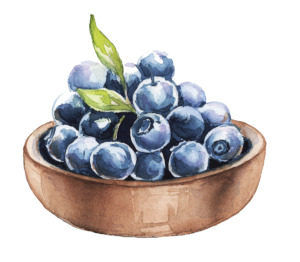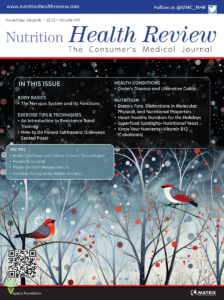 Although the summer is coming to a close, there is plenty of time to learn more about Cyanococcus vaccinium, also known as the blueberry.1 These small berries, the second most popular in the United States after strawberries, are native to North America and have been used in food, medicine, and for artistic purposes for thousands of years. History aside, they are often garnered as a superfood, and for good reason; this small but mighty fruit packs a nutritional punch. 2
Although the summer is coming to a close, there is plenty of time to learn more about Cyanococcus vaccinium, also known as the blueberry.1 These small berries, the second most popular in the United States after strawberries, are native to North America and have been used in food, medicine, and for artistic purposes for thousands of years. History aside, they are often garnered as a superfood, and for good reason; this small but mighty fruit packs a nutritional punch. 2
Benefits
Blueberries provide an array of health benefits, including their high level of antioxidants. Antioxidants protect your body from an imbalance of free radicals, which are unstable, reactive molecules that can damage cells.3,4 While free radicals and antioxidants are part of the body’s natural functioning, their imbalance can trigger a response called oxidative stress. This process can damage cells and make the body more susceptible to disease, aging, and increased inflammation in the body. Antioxidants can set a strong foundation for your health overall, and blueberries are believed to have one of the highest antioxidant levels of all common fruits and vegetables.2
Low in calories, high in nutrients. Blueberries are a rich source of vitamins and minerals, specifically vitamin C, vitamin K1, and manganese. They also contain trace amounts of copper, as well as vitamins E and B6.2,5 A one-cup serving only contains 84 calories and 15 grams of carbohydrates. In terms of nutritional density, this makes blueberries an excellent source of nutrients.
Boost cardiovascular health. The nutrients in blueberries play an important role in preventing cardiovascular disease, specifically by preventing arterial plaque buildup. In addition to the absence of cholesterol and presence of fiber, the antioxidants found in blueberries can inhibit the oxidation and accumulation of low-density lipoprotein cholesterol, commonly referred to as the “bad” cholesterol.5,7 Likewise, vitamin K1 helps regulate blood pressure by hindering mineralization in arteries.8 The anti- inflammatory properties of blueberries share a similar role, as inflammation can also cause a buildup of plaque.5,9 Because blueberries can prevent arterial buildup, less stress is put on the heart, which can pump blood more freely throughout the body. This can decrease your risk of heart disease and stroke.
Improve brain health. Blueberries can improve brain function by slowing brain aging, preventing memory loss, and preventing neurodegenerative diseases.4,7 Their antioxidants can lessen oxidative stress and inflammation, which are both major contributors to the development of age-related, declining brain conditions.10 These neuroprotective effects happen through improving communication between brain cells. These modifications can mediate the enhancements in cognitive and motor behavioral performance.
How Blueberries Get Their Color
Blueberries contain a flavonoid called anthocyanin. Flavanoids are plant compounds that often have potent antioxidant and anti-inflammatory effects.3 Anthocyanins, which can also be found in plums, melons, and cherries, are what give blueberries their characteristic blue and purple color and account for their high level of antioxidants.
Highbush vs. Lowbush Blueberries
There are two types of blueberries: highbush and lowbush.14 Highbush blueberries are the most common cultivated variety in the United States that you typically find in grocery stores. They are plump and grow on large scales throughout North America. Lowbush, or “wild” blueberries, are typically smaller and richer in some antioxidants. They are native to Maine and grow on smaller shrubs.
Blueberries at a Glance
- Blueberries are native to North America and have been around for more than 13,000 years, but it wasn’t until 1916 that this versatile little berry was successfully cultivated for mass consumption.1
- Blueberries in North America are in season from April through September, peaking in the summer months.12
- There are 38 states that grow blueberries commercially, but only ten states account for more than 98 percent of commercial production in the US: California, Florida, Georgia, Indiana, Michigan, Mississippi, New Jersey, North Carolina, Oregon, and Washington.12
- Hammonton, New Jersey has been called the Blueberry Capital of the World, with Atlantic County producing about 57 million pounds of blueberries per year.13
Sources
- Brown L. What Makes Blueberries Superfoods? JSTOR Daily website. Updated June 29, 2016. https://daily.jstor.org/what-makes-blueberries-superfoods/. Accessed August 1, 2020.
- Leech J. 10 Proven Health Benefits of Blueberries. Healthline website. Updated October 9, 2018. https://www.healthline.com/nutrition/10-proven-benefits-of-blueberries. Accessed August 1, 2020.
- Ware M. Everything you need to know about blueberries. Medical News Today website. Updated September 5, 2017. https://www.medicalnewstoday.com/articles/287710. Accessed August 1, 2020.
- Lobo V, Patil A, Phatak A, et al. Free radicals, antioxidants and functional foods: Impact on human health. Pharmacogn Rev. 2010;4(8):118–126.
- Ma L, Sun Z, Zeng Y, et al. Molecular mechanism and health role of functional ingredients in blueberry for chronic disease in human beings. Int J Mol Sci. 2018;19(9):2785.
- Kalt W, Cassidy A, Howard LR, et al. Recent research on the health benefits of blueberries and their anthocyanin. ADV NUTR. 2020;11(2):224–236.
- Palsdottir H. Blueberries 101: Nutrition Facts and Health Benefits. Healthline website. Updated February 20, 2019. https://www.healthline.com/nutrition/foods/blueberries. Accessed August 3, 2020.
- Carter A. Health benefits and sources of vitamin K. Medical News Today website. Updated January 22, 2018. https://www.medicalnewstoday.com/articles/219867. Accessed August 3, 2020.
- How to use food to help your body fight inflammation. The Mayo Clinic website. Updated August 13, 2019. https://www.mayoclinic.org/healthy-lifestyle/nutrition-and-healthy-eating/in-depth/how-to-use-food-to-help-your-body-fight-inflammation/art-20457586. Accessed August 3, 2020.
- Subash S, Essa MM, Al-Adawi S, et al. Neuroprotective effects of berry fruits on neurodegenerative diseases. Neural Regen Res. 2014;9(16):1557–1566.
- About Blueberries. The U.S. Highbush Blueberry Council website. https://www.blueberrycouncil.org/about-blueberries/. Accessed August 3, 2020.
- Growing Blueberries. The U.S. Highbush Blueberry Council website. https://www.blueberrycouncil.org/growing-blueberries/where-blueberries-grow/. Accessed August 3, 2020.
- Pistone S. What makes Hammonton the ‘blueberry capital of the world?’ A look inside during season’s peak. NJ.com website. Updated January 17, 2019. https://www.nj.com/atlantic/2015/06/berries_by_the_numbers_an_in-depth_look_into_hammo.html. Accessed August 3, 2020.
- Marie J. Highbush Blueberries vs. Lowbush. San Francisco Chronicle website. https://homeguides.sfgate.com/highbush-blueberries-vs-lowbush-29271.html. Accessed August 3, 2020.





